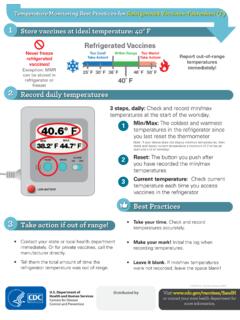Transcription of Navy Force Structure and Shipbuilding Plans: Background ...
1 Navy Force Structure and Shipbuilding Plans: Background and Issues for Congress Ronald O'Rourke Specialist in Naval Affairs April 16, 2018 Congressional Research Service 7-5700 RL32665 Navy Force Structure and Shipbuilding Plans: Background and Issues for Congress Congressional Research Service Summary The current and planned size and composition of the Navy, the rate of Navy ship procurement, and the prospective affordability of the Navy s Shipbuilding plans have been oversight matters for the congressional defense committees for many years. The Navy s FY2019 budget submission includes proposed increases in Shipbuilding rates that are intended as initial steps for increasing the size of the Navy toward a goal of a fleet with 355 ships of certain types and numbers. The Navy s proposed FY2019 budget requests funding for the procurement of 10 new ships, including two Virginia-class attack submarines, three DDG-51 class Aegis destroyers, one Littoral Combat Ship (LCS), two John Lewis (TAO-205) class oilers, one Expeditionary Sea Base ship (ESB), and one TATS towing, salvage, and rescue ship.
2 The total of 10 new ships is one more than the 9 that the Navy requested in its amended FY2018 budget submission, 3 less than the 13 battle Force ships that were funded in the FY2018 DOD appropriations act, and 3 more than the 7 that were projected for FY2019 in the Navy s FY2018 budget submission. The three added ships include one DDG-51 class destroyer, one TAO-205 class oiler, and one ESB. The Navy s FY2019 five-year (FY2019-FY2023) Shipbuilding plan includes 54 new ships, or an average of new ships per year. The total of 54 new ships is 12 more than the 42 that were included in the Navy s FY2018 five-year (FY2018-FY2022) Shipbuilding plan, and 11 more than the 43 that the Navy says were included in the five-year period FY2019-FY2023 under the Navy s FY2018 budget submission. (The FY2023 column was not visible to Congress in the Navy s FY2018 budget submission.)
3 The 11 ships that have been added to the five-year period FY2019-FY2023, the Navy says, are four DDG-51 class destroyers, three TAO-205 class oilers, two ESBs, one TATS, and one TAGOS ocean surveillance ship. The Navy s FY2019 30-year (FY2019-FY2048) Shipbuilding plan includes 301 new ships, or an average of about 10 per year. The total of 301 ships is 47 more than the 254 that were included in the Navy s FY2017 30-year (FY2017-FY2046) Shipbuilding plan. (The Navy did not submit an FY2018 30-year Shipbuilding plan.) The Navy s goal for achieving and maintaining a fleet of 355 ships, released in December 2016, is 47 ships higher than the Navy s previous Force -level goal of 308 ships. The Force level of 355 ships is a goal to be attained in the future; the actual size of the Navy in recent years has generally been between 270 and 290 ships.
4 Section 1025 of the FY2018 National Defense Authorization Act ( 2810 115-91 of December 12, 2017) states in part: It shall be the policy of the United States to have available, as soon as practicable, not fewer than 355 battle Force ships, comprised of the optimal mix of platforms, with funding subject to the availability of appropriations or other funds. Although the 355-ship Force -level goal is 47 ships higher than the previous 308-ship Force -level goal, achieving and maintaining the 355-ship fleet within 30 years would require adding more than 47 ships to the Navy s previous (FY2017) 30-year Shipbuilding plan, in part because that plan did not include enough ships to fully achieve all elements of the 308-ship Force -level goal. CRS estimated in 2017 that 57 to 67 ships would need to be added to the Navy s FY2017 30-year Shipbuilding plan to achieve the Navy s 355-ship fleet and maintain it through the end of the 30-year period ( , through FY2046), unless the Navy extends the service lives of existing ships beyond currently planned figures and/or reactivates recently retired ships.
5 Similarly, the Congressional Budget Office (CBO) estimated in 2017 that 73 to 77 ships would need to be added to a CBO-created notional version of the Navy s FY2018 30-year (FY2018-FY2047) Shipbuilding plan to achieve the Navy s 355-ship fleet and maintain it not only through the end of the 30-year period ( , through FY2047), but another 10 years beyond the end of the 30-year Navy Force Structure and Shipbuilding Plans: Background and Issues for Congress Congressional Research Service period ( , through FY2057), unless the Navy extends the service lives of existing ships beyond currently planned figures and/or reactivates recently retired ships. Consistent with these CRS and CBO estimates, the Navy projects that the 47 additional ships included in the Navy s FY2019 30-year Shipbuilding plan would not be enough the achieve a 355-ship fleet during the 30-year period.
6 The Navy projects that if the FY2019 30-year Shipbuilding plan were implemented, the fleet would peak at 342 ships in FY2039 and FY2041, and then drop to 335 ships by the end of the 30-year period. The Navy projects that under the FY2019 30-year Shipbuilding plan, a 355-ship fleet would not be attained until the 2050s (and the aircraft carrier Force -level goal within the 355-ship goal would not be attained until the 2060s). Consistent with CRS and CBO estimates from 2017, the Navy estimates that adding another 20 to 25 ships to the earlier years of the Navy s FY2019 30-year Shipbuilding plan (and thus procuring a total of 321 to 326 ships in the 30-year plan, or 67 to 72 ships more than the 254 included in the FY2017 30-year plan) could accelerate the attainment of a 355-ship fleet to about 2036 or 2037. At a hearing on April 12, 2018, Navy officials announced that the Navy has decided to extend the service lives of all DDG-51 destroyers to 45 years.
7 Navy officials testified that this action would permit the Navy to achieve a total of 355 ships by the 2030s, although the resulting mix of ships would not match the mix called for in the Navy s 355-ship Force -level goal there would be more than the required number of DDG-51s, and fewer than the required numbers of other types of ships. CRS estimated in 2017 that procuring the 57 to 67 ships that would need to be added to the Navy s FY2017 30-year Shipbuilding plan to achieve the Navy s 355-ship fleet and maintain it through FY2046 (unless the Navy extends the service lives of existing ships beyond currently planned figures and/or reactivates recently retired ships) would notionally cost an average of roughly $ billion to $ billion per year in additional Shipbuilding funds over the 30-year period, using today s Shipbuilding costs.
8 Similarly, CBO estimated in 2017 that procuring the 73 to 77 ships that would need to be added to the CBO-created notional version of the Navy s FY2018 30-year Shipbuilding plan to achieve the Navy s 355-ship fleet and maintain it through FY2057 (unless the Navy extends the service lives of existing ships beyond currently planned figures and/or reactivates recently retired ships) would cost, in constant FY2017 dollars, an average of $ billion per year in additional Shipbuilding funds over the 30-year period. Additional Shipbuilding funds are only a fraction of the total costs that would be needed to achieve and maintain the Navy s 355-ship fleet instead of the previously envisaged 308-ship fleet. CBO estimated in 2017 that, adding together both Shipbuilding costs and ship operation and support (O&S) costs, the Navy s 355-ship fleet would cost an average of about $11 billion to $23 billion more per year in constant FY2017 dollars than the previously envisaged 308-ship fleet.
9 This figure does not include additional costs for manned aircraft, unmanned systems, and weapons. Depending on total levels of defense spending in coming years, achieving and maintaining a 355-ship fleet could require reducing funding levels for other Department of Defense (DOD) programs. The Shipbuilding industrial base has some unused capacity to take on increased Navy Shipbuilding work, particularly for certain kinds of surface ships, and its capacity could be increased further over time to support higher Navy Shipbuilding rates. Navy Shipbuilding rates could not be increased steeply across the board overnight time (and investment) would be needed to hire and train additional workers and increase production facilities at shipyards and supplier firms, particularly for supporting higher rates of submarine production. Over a period of a few to several years, with investment and management attention, Navy Shipbuilding could ramp up to higher rates for achieving a 355-ship fleet over a period of 20 to 30 years.
10 Navy Force Structure and Shipbuilding Plans: Background and Issues for Congress Congressional Research Service Contents Introduction .. 1 Background .. 2 Navy s 355-Ship Ship Force - Structure Goal .. 2 Introduction .. 2 Made Policy by FY2018 2 Part of Navy the Nation Needs (NNN) Vision .. 4 Apparent Reasons for Increasing Force -Level Goal from 308 Ships .. 4 Compared to Trump Campaign Organization Goal of 350 Ships .. 5 Additional Shipbuilding Needed to Achieve and Maintain 355-Ship Fleet .. 6 Time Needed to Achieve 355-Ship Fleet .. 7 Cost to Achieve and Maintain 355-Ship Fleet .. 7 Industrial Base Ability for Taking on Additional Shipbuilding Work .. 9 Employment Impact of Additional Shipbuilding Work .. 10 Extending Service Lives of Existing Ships and Reactivating Retired Ships .. 10 Navy s Five-Year and 30-Year Shipbuilding Plans.












